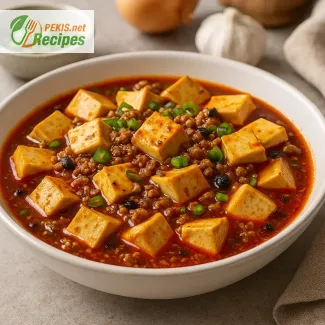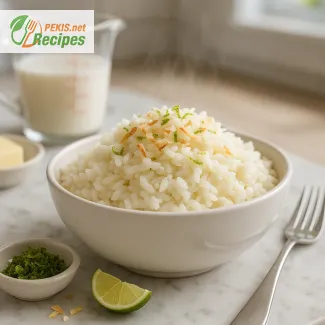
Discover the Bold Flavors of Traditional Mapo Tofu from Sichuan
A fiery, fragrant, and comforting dish with authentic roots and modern ease
Mapo tofu is a legendary Sichuan specialty, deeply rooted in the province’s rich culinary tradition and celebrated for its bold flavors, mouth-tingling spices, and silky texture. This dish masterfully combines soft tofu with a savory meat sauce infused with the iconic numbing heat of Sichuan peppercorns, creating a balance that’s as addictive as it is satisfying. While it might look complex, a properly crafted version can be made at home in just 30 minutes — without sacrificing authenticity or depth.
Often misunderstood as just another tofu dish, Mapo tofu is anything but ordinary. It’s a dish born from humble origins yet revered across Asia and beyond. The name "Mapo" refers to the pockmarked old woman who first popularized it in Chengdu, the capital of Sichuan, in the late 19th century. Her small restaurant became known for serving locals a dish that was spicy, numbing, aromatic, and hearty — everything the Sichuan palate craves. Over time, this dish has transcended regional borders and become a staple in Chinese restaurants around the world.
What makes authentic Sichuan Mapo tofu truly exceptional is its layered umami profile. It’s not just spicy — it’s rich, savory, fragrant, and complex. The sauce begins with a base of fermented broad bean paste (doubanjiang), a cornerstone of Sichuan cooking. This red, pungent paste lays the groundwork for a flavor explosion, complemented by fermented black beans (douchi), garlic, and ginger. Ground pork or beef adds richness, while toasted Sichuan peppercorns contribute the signature tingling sensation known as “málà.”
But flavor is only part of the experience. Texture plays an equally crucial role. The tofu must be silken yet firm enough to hold its shape, absorbing the flavors of the sauce without disintegrating. The final dish should shimmer with a vibrant red oil — not greasy, but a sign of the proper balance between spice and aroma.
Modern interpretations often compromise for convenience or tame the heat for broader appeal. This version honors tradition without overcomplication. It focuses on technique, ingredient authenticity, and balance, ensuring that even a novice can produce a dish that feels like it came straight from a Chengdu kitchen. And though it’s ready in 30 minutes, it captures every nuance of what makes this dish iconic.
Mapo tofu isn’t just a meal; it’s a culinary statement, representing the heart of Sichuan cooking — where fire meets flavor, and comfort meets complexity. Whether served over steamed rice or enjoyed as part of a larger meal, it delivers an unforgettable punch of taste and tradition in every bite.
For anyone who loves bold spices, dynamic flavors, and authentic Asian cuisine, this is a dish you need in your repertoire. From its historical roots to its explosion of taste, Mapo tofu is proof that the best meals come from time-honored techniques, a few exceptional ingredients, and the courage to cook boldly.
- Prepare the ingredients: Cut the tofu into 2–3 cm (1 inch) cubes. Mince the garlic and ginger. Rinse and chop the scallions, separating the white and green parts. Rinse the fermented black beans and lightly crush them.
- Blanch the tofu (optional but recommended): Bring a pot of lightly salted water to a gentle simmer. Add the tofu cubes and simmer for 2–3 minutes to firm up the texture. Drain and set aside.
- Cook the aromatics: In a wok or deep skillet, heat the vegetable oil over medium heat. Add the white parts of the scallions, garlic, and ginger. Sauté for 30 seconds until fragrant.
- Add the pork: Increase to medium-high heat. Add the ground pork and stir-fry until no longer pink and slightly crisp.
- Add flavor bases: Stir in the doubanjiang and douchi. Cook for 1–2 minutes to release their full aroma and deepen the flavor.
- Deglaze and simmer: Pour in the Shaoxing wine, soy sauce, and chicken broth. Stir to combine. Bring to a simmer.
- Add tofu: Carefully add the tofu cubes and gently stir to coat in the sauce. Simmer for 5–6 minutes, letting the tofu absorb the flavors.
- Thicken the sauce: Mix the cornstarch and cold water in a small bowl. Pour the slurry into the pan while gently stirring. Cook until the sauce thickens, about 1–2 minutes.
- Finish the dish: Drizzle chili oil over the top. Sprinkle with ground Sichuan peppercorns. Garnish with green scallion tops. Serve hot with steamed rice.
Elevating the Classic Mapo Tofu: Creative Twists for a Modern Kitchen
Transforming tradition with technique, flavor, and healthier alternatives
Mapo tofu is already a bold, deeply flavorful dish, but even the most iconic recipes can be refined with thoughtful adjustments. Whether you’re cooking for dietary preferences, refining textures, or simply exploring new dimensions of flavor, enhancing this Sichuan classic is both an exciting and rewarding culinary exercise. By understanding ingredient functions and common mistakes, you can customize Mapo tofu while respecting its origins.
The power of better ingredients and mindful substitutions
Use high-quality tofu and understand your options
Choosing the right tofu makes a noticeable difference. Silken tofu absorbs flavors quickly and offers a delicate mouthfeel but may break easily during stirring. Medium-firm tofu, however, retains its shape while still absorbing the sauce beautifully. For those preferring a meatier bite, pressed tofu or extra-firm tofu can offer a more resilient texture, though they will absorb flavors more slowly.
Some cooks blanch tofu in salted water before cooking. This technique tightens the surface, helping it retain shape while absorbing more sauce and reducing its beany aroma — a simple trick with great returns.
Try different proteins for unique flavor profiles
Traditional Mapo tofu uses ground pork, but replacing it with other proteins can significantly affect both flavor and nutritional value. Ground beef adds depth and richness, while ground chicken or turkey offer lighter options with lower fat content. For a fully plant-based version, consider finely chopped shiitake mushrooms, textured vegetable protein (TVP), or crumbled tempeh, all of which replicate the meat texture and umami without sacrificing authenticity.
Enhancing depth of flavor with regional touches
Doubanjiang quality matters
Not all doubanjiang (fermented broad bean paste) is created equal. Pixian doubanjiang, imported from Sichuan, is the gold standard — deeply fermented, complex, and naturally spicy. Cheaper varieties can taste flat or overly salty. Investing in a quality version will elevate the sauce’s complexity dramatically.
Toast your spices and aromatics
To fully develop the flavor of Sichuan peppercorns, toast them gently in a dry pan until fragrant before grinding. This enhances their citrusy aroma and numbing effect. Similarly, bloom the doubanjiang and black beans in oil to release their aromatic oils and remove bitterness. These small steps unlock deeper, layered flavors that distinguish a restaurant-quality dish from a basic homemade attempt.
Adding vegetables and texture for balance
Mapo tofu is inherently rich and oily. To lighten the dish and add contrast, try folding in some diced eggplant, zucchini, or bok choy during the simmering phase. These vegetables soak up the sauce beautifully and bring freshness. Adding a few wood ear mushrooms or water chestnuts introduces crunch and elevates textural variety.
Common mistakes and how to avoid them
Overcooking tofu
Many home cooks stir tofu too vigorously or leave it on high heat too long. This causes it to crumble or become rubbery. Gently folding tofu into the sauce and simmering at low to medium heat ensures a tender texture that holds flavor without falling apart.
Under-seasoning the sauce
A successful Mapo tofu sauce must balance saltiness, spice, and umami. Relying solely on soy sauce or doubanjiang can result in an unbalanced flavor. Taste as you go and adjust with small amounts of sugar, vinegar, or even a splash of dark soy sauce to round out the flavor.
Not using Sichuan peppercorns correctly
Using raw, un-toasted, or stale peppercorns diminishes their pungent effect. Always toast and grind fresh batches. Also, don’t overuse them — they should tingle, not numb the entire mouth.
Healthier and modern interpretations
Reduce oil without losing flavor
Traditionally, Mapo tofu uses a generous amount of oil. To make it lighter, reduce the initial oil by half and opt for vegetable or avocado oil with a high smoke point. Use only enough chili oil to coat the tofu for presentation and mouthfeel, not to drown it.
Sodium-conscious cooking
Many components (doubanjiang, soy sauce, fermented beans) contain salt. Use low-sodium soy sauce, and rinse fermented black beans thoroughly to reduce sodium load. This allows better control over seasoning without sacrificing depth.
Add whole grains
While white rice is the classic companion, serving Mapo tofu with brown rice, quinoa, or barley adds fiber and nutrients, creating a more balanced and health-conscious plate.
Why homemade always wins
Making Mapo tofu at home gives you full control over ingredients, oil levels, and spice balance. Store-bought or restaurant versions often use excessive oil, sugar, or MSG to shortcut flavor. Cooking it yourself allows you to maintain authenticity while adjusting to your preferences — more heat, less fat, richer umami, or vegetarian adaptations.
It’s also more cost-effective, especially with fermented ingredients that last for months. Once you’ve stocked a few pantry staples like doubanjiang, douchi, and Sichuan peppercorns, you’re ready to explore countless other Chinese recipes, making Mapo tofu the gateway to Sichuan cooking in your home kitchen.
The best way to improve Mapo tofu is by understanding the original and then adjusting thoughtfully. Through precise technique, better ingredients, and creative yet respectful additions, this beloved dish becomes not just authentic, but deeply personal. It’s a reminder that tradition isn’t fixed — it’s a foundation to build upon with curiosity, care, and good taste.
Allergens present in the recipe:
- Soy (tofu, soy sauce, doubanjiang)
- Gluten (doubanjiang, soy sauce, Shaoxing wine may contain wheat)
Allergen substitution tips:
- Use tamari instead of soy sauce to avoid gluten
- Choose gluten-free doubanjiang and Shaoxing wine if available
- Replace tofu with chickpea tofu or tempeh for soy allergies (taste will differ)
Vitamins and minerals per serving (approximate):
- Vitamin B1 (Thiamine): 0.2 mg – supports energy metabolism
- Vitamin B12: 0.4 µg – aids in nerve function and red blood cell production
- Vitamin K: 12 µg – essential for blood clotting
- Calcium: 200 mg – supports bone health
- Iron: 3 mg – contributes to oxygen transport in the blood
- Magnesium: 45 mg – important for muscle and nerve function
- Phosphorus: 250 mg – necessary for healthy bones and teeth
- Zinc: 2.5 mg – boosts immune function and wound healing
Antioxidants per serving (approximate):
- Isoflavones (from tofu): 20–25 mg – may help reduce inflammation and support heart health
- Capsaicin (from chili): 5 mg – supports metabolism and pain reduction
- Gingerol (from ginger): 3 mg – known for anti-inflammatory and anti-nausea effects
- Ferulic acid (from garlic and beans): 2 mg – offers cell protection against oxidative stress





